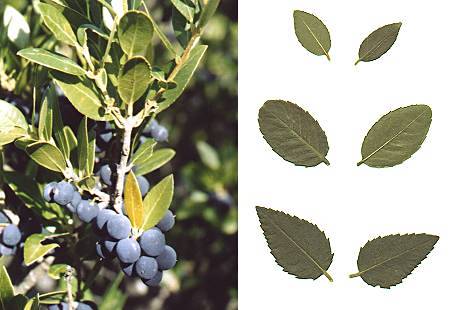Herrera, C. M., P. Jordano, L. López Soria and J. A. Amat. 1994.
Recruitment of a mast-fruiting, bird-dispersed tree: bridging frugivore activity
and seedling establishment. Ecological Monographs 64: 315-344.
 The recruitment of Phillyrea latifolia L. (Oleaceae), a bird-dispersed tree of Mediterranean forest, is described. Fruit removal by birds, seed rain, post-dispersal seed predation, seed germination, and seedling emergence, survival, and establishment were studied. The main objective was testing whether seed dispersal by birds produced a predictable seedling shadow as a result of coupled patterns of seed rain, seedling emergence, and seedling establishment. P. latifolia is a mast-fruiting species and large fruit
crops were produced in only 2 (1981 and 1989) out of 15 yr (1978-1992). We
report here on the 1989 fruiting event at one scrubland and one forest site.
The recruitment of Phillyrea latifolia L. (Oleaceae), a bird-dispersed tree of Mediterranean forest, is described. Fruit removal by birds, seed rain, post-dispersal seed predation, seed germination, and seedling emergence, survival, and establishment were studied. The main objective was testing whether seed dispersal by birds produced a predictable seedling shadow as a result of coupled patterns of seed rain, seedling emergence, and seedling establishment. P. latifolia is a mast-fruiting species and large fruit
crops were produced in only 2 (1981 and 1989) out of 15 yr (1978-1992). We
report here on the 1989 fruiting event at one scrubland and one forest site.
Ripe fruits were available from mid-September to early June. Extensive removal
by birds started after fruit crops of other species were depleted. Seed dispersers
were more abundant, and fruit predators more scarce, in scrubland than in
forest. P. latifolia fruits were a major component in the diet of principal
seed dispersers (Sy1via atricapilla and Erithacus rubecula)
that depended almost exclusively on them for food late in the season. Fruit
removal levels were higher, crops were depleted earlier, and individual plants
dispersed more seeds in scrubland than in forest. Crop size was the best predictor
of number of seeds dispersed by individual plants in scrubland, while fruit
characteristics were more influential in forest. Seed dispersal was largely
a within-population phenomenon, as no seed fall occurred in traps set beyond
the distributional limits of P. latifolia in the study region. Frugivores
produced a spatially predictable seed rain at the two sites. Seed rain was
greatest beneath fleshy fruit-producing species (under female individuals
in dioecious species) in scrubland and at forest-gap interfaces in forest.,
Post-díspersal seed predation was low at the two sites (39 and 54%
after 1-yr exposure). In forest, seed survival was lower in gaps than in forest
interior or forest edges. In scrubland, seed survival differed widely among
microhabitats (defined by overlying plant species), ranging from 19% (open
ground) to 61 % (beneath Rosmarinus officinalis). In forest, density
of emerging seedlings was unrelated to location in the habitat mosaic (gap,
forest edge, interior). Seedling density did differ among microhabitats in
scrubland, where emergence was greatest under fleshy fruit-producing species.
Seedling survival was higher in forest than in scrubland, where seedlings
incurred greater mortality due to desiccation. In both sites, seedling survival
depended significantly on microhabitat and was depressed under adult conspecifics.
The activity offrugivores direaly impacted seedling distribution in scrubland,
as spatial patterns of seed deposition were not overshadowed by later-acting
factors, such as rodent seed predation or variation in germination. In forest,
there was spatial discordance between seed rain and seedling distribution,
as a consequence of uncoupled seed rain and seedling emergence. Spatial patterns
of seed deposition by birds may thus have a lasting impact on the populafion
dynarnics of P. latifolia, but this will vary among populations depending
on the extent of coupling of the different stages in the recruitment process
(dispersal-seed rain-germination and seedling establishment).
Keywords
avian frugivory; fleshy fruits; mast fruiting; Mediterranean scrublands, mutualism; Oleaceae; plant demography; post-dispersal seed predation; recruitment; seed dispersal; seedling survivorship; Spain.
| Photo: Ripe fruits and leaves of Phillyrea latifolia. |
Please, send an email to me (
) if you are interested in getting a reprint, copy, or additional information. You can also have a complete list of all my publications.
Or write to the postal address:
Pedro Jordano
Estación Biológica de Doñana,CSIC
Pab. Perú, Avda. M. Luisa S/N
E-41013 Sevilla, Spain
 The recruitment of Phillyrea latifolia L. (Oleaceae), a bird-dispersed tree of Mediterranean forest, is described. Fruit removal by birds, seed rain, post-dispersal seed predation, seed germination, and seedling emergence, survival, and establishment were studied. The main objective was testing whether seed dispersal by birds produced a predictable seedling shadow as a result of coupled patterns of seed rain, seedling emergence, and seedling establishment. P. latifolia is a mast-fruiting species and large fruit
crops were produced in only 2 (1981 and 1989) out of 15 yr (1978-1992). We
report here on the 1989 fruiting event at one scrubland and one forest site.
The recruitment of Phillyrea latifolia L. (Oleaceae), a bird-dispersed tree of Mediterranean forest, is described. Fruit removal by birds, seed rain, post-dispersal seed predation, seed germination, and seedling emergence, survival, and establishment were studied. The main objective was testing whether seed dispersal by birds produced a predictable seedling shadow as a result of coupled patterns of seed rain, seedling emergence, and seedling establishment. P. latifolia is a mast-fruiting species and large fruit
crops were produced in only 2 (1981 and 1989) out of 15 yr (1978-1992). We
report here on the 1989 fruiting event at one scrubland and one forest site.